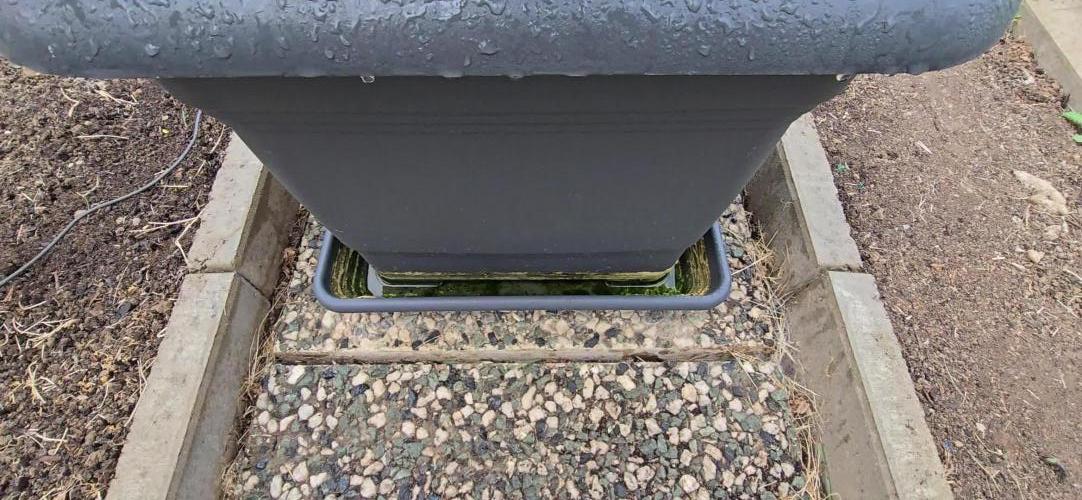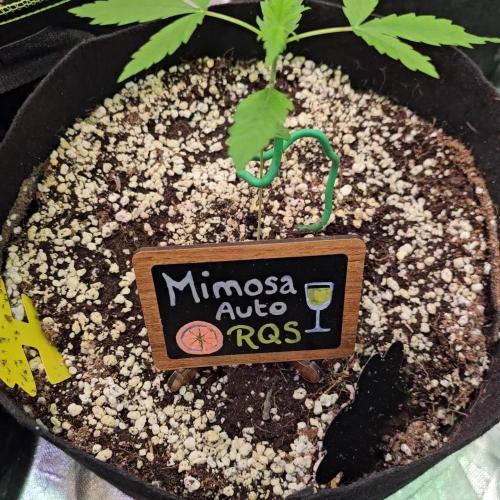The Grow Awards 2026 🏆 





































Likes
Comments
Share


@SonomaSungrown
Follow
Skipped a week in my journal due to travels.
Had my neighbor water my plants.
Having some minor early deficiencies with my photoperiod plants (particularly the chem brulee)... so I decided to go ahead and give everything a solid feeding of Foop Bloom 1, 2 and Sweetener. This is their first ever bottled feeding. Have been running on supersoil and a prayer.
Also top dressed everything and mulched with rice straw to help with the soil drying out a bit too quickly.
Leaves have been yellowing on all three. Mostly relegated to the interior of the plants.
Chem Brulee is looking a bit too yellow overall, as well.
French Macaron is a 66in. Chem Brulee is 56in. Pineapple Meatball is 45in.
I have a sneaking suspicion that my neighbor didn't water them quite enough while I was gone.
Will probably continue with the Foop feedings... probably at least once per week. Don't want to overdo it.
Also top dressed with my flowering top dress mix and mulched all plants with a thin layer of rice straw.
8/4 Sprayed with Neem Oil and Castile Soap
8/5 Sprayed with Gravenstein Apple FFJ and OHN
8/6 Sprayed with Neem Oil and Castile Soap (this will likely be the last time I spray with Neem Oil, as I don't want residual oils as buds start swelling. Also fed 1/4 strength FOOP to ensure we head off any deficiencies.
Likes
2
Share


@Jxkptx
Follow
An Tag 23 habe ich das LST neu angepasst um die kleine niedrig und buschig zu halten.
An Tag 24 habe ich fast alle großen Fächerblätter entfernt und das LST erneut angepasst.
An Tag 25 erneut LST angepasst.
An Tag 27 wurden zu viele der unteren Triebe mit Schatten bedeckt, so dass ich einiger der Blätter wegnehmen musste.
Likes
23
Share


@MistaOC
Follow
*******************************************
11.02. Day 16
*******************************************
13.02. Day 18
*******************************************
16.02. Day 21
*******************************************
Likes
13
Share


@Aedaone
Follow
Seeds were left in water overnight to simulate an all night soaking rain. The next day they were direct sown .75" deep into moist soil. They were left outside and because of the 40° nights took 4 days to pop. he soil was premixed with 15ml of rock dust and top dressed with the above listed nutrient at the listed ml rate per gallon of soil. 35ml of coop poop and 21ml of blood meal were mixed together and top dressed in a ring around plants, when they popped.
Likes
13
Share


@NSABND
Follow
Let´s start a new week 😎👌
Day36 very sunny and warm... "Hilde 2.0" goes well 😎👍🙏
Day37 starts with massive cloudy weather but later it turns into a sunny afternoon 😏🙏
Day38 was cloudy and rainy and not so much sun around here 😳😵
Day39 damn cloudy and rain....wth is this summer doing 😵😧
Day40 wth is wrong with this summer 😡 cloudy and rain and no sun 😵😨
Likes
13
Share


@DieselKush
Follow
Oct.29 - We transplanted the girls into soil since they are moving into vegetation phase
Nov.4 - Watered each plant 250mL, 0.25mL of each nutrient for each girl
Likes
69
Share


@DogDoctorOfficial
Follow
Week 13 from Seed | Week 2 Flower - Eternity Grow Cup Update
April marks a fresh beginning, a new season, and a new stage in our Eternity Grow Cup journey. While many celebrate April Fool’s, for me, this is a time of progress and transformation in the garden. 🌱( and yes i know i am a coupe weeks back on the dates in here, but today still the 1st of April so still new year to me )
This week, the girls are filling up their space beautifully. While I continue bending them to maximize coverage, they remain incredibly compact—short, strong, and resilient. No extreme stretching, just thick, vigorous plants showing their best potential. Each of the five ladies is looking absolutely stunning.
TrolMaster Ecosystem in Action
The full TrolMaster system is running smoothly, allowing for optimal environmental control. Currently, I am using full spectrum with the reds, but I have yet to introduce UV into the mix. The girls are responding well to the setup, and I’m loving how everything is coming together.
Room Conditions
PPFD: 750
Temperature: 26.6°C
Humidity: 68.9%
CO2 Levels: 1200 PPM
The environment is staying in a great range, ensuring that the plants can thrive under perfect conditions.
Reservoir & Soil Data
pH: 5.97 (Holding steady at 5.8)
Water Temperature: 18.7°C (Still a bit low—I need to make adjustments)
Soil EC: 1.09
Soil Temperature: 21.8°C (Better, but aiming for 22-23°C)
Humidity remains a crucial factor, even in flower, so I’m continuing to use humidifiers to keep the levels stable. The air is quite dry, but managing it properly is key to keeping the girls happy.
A Look Into the Grow Space
I’ve shared some full-room shots so you can all get a better idea of my workspace. Having an organized, clean, and efficient grow area is essential for a smooth and successful run. Let me know what you think of the setup!
A huge THANK YOU to Zamnesia, Plagron, and Grow Diaries for making this contest possible. The competition is heating up, and I want to wish all the growers the best of luck in the Eternity Grow Cup! Your dedication and passion inspire me every day.
Big love to my sponsors and the entire community—whether you’re here for the love, the knowledge, or even the hate (yes, I see you too 😆)—I apprecilove each and every one of you!
Stay Tuned!
We’re just getting started in flower, and the best is yet to come. Keep an eye on the updates, and don’t forget to check out YouTube for 4K episodes and more detailed insights into the grow!
Let’s grow together!
Genetics - Runtz https://www.zamnesia.com/6000-zamnesia-seeds-runtz-feminized.html
Nutrients - Plagron https://plagron.com/en/hobby
- Aptus Holland https://aptus-holland.com/
Controls - Trol Master https://www.trolmaster.eu/
LED - https://www.futureofgrow.com/en
LED - https://www.thinkgrowled.com
Soil - https://www.promixgardening.com/en
Germination - Cannakan https://cannakan.com/?srsltid=AfmBOopXr-inLXajXu3QFgKXCXXos4F1oEvScjMKIB5MR5dk8-GJ-F49
DOGDOCTOR 15% off
Smoking Papers - https://ziggioriginal.com/
Terpene saver - https://grovebags.com/
As always thank you all for stopping by, for the love and for it all , this journey of mine wold just not be the same without you guys, the love and support is very much appreciloved and i fell honored with you all in my life
With true love comes happiness Always believe in your self and always do things expecting nothing and with an open heart , be a giver and the universe will give back to you in ways you could not even imagine so
As always, this is shared for educational purposes, aiming to spread understanding and appreciation for this plant. The journey with nature is one of discovery, creativity, and respect. Let’s celebrate it responsibly and continue to learn and grow together!
Growers Love To you All 💚
#EternityGrowCup #RuntzHunt #GrowersLove #CannabisCommunity #AptusHolland #ProMixSoil #TrolMaster #Zamnesia #Plagron #ZiggiPapers #Grovebags
Processing
Likes
18
Share


@Divs_darkroom
Follow
Gave her an xtreme gardening tea with Be1 and Be2 added. Also threw in some seafuel from bloom yellow. The plant is looking amazing and is blowing up like crazy. Everyday I notice more growth. And I just got a new light that should be here today so I'm super stoked. The cover crop is a pain in the ass but growing this with fungus and microbes in the pot is amazing and the plant loves it. Next round I'll buy a bigger pot and amend the soil so I'll be more set flower without adding so much in teas and waterings. This is my learning run. And all is good ✌️.
Likes
70
Share


@KilgoreTrout
Follow
Honestly these weeks are boring. I’m gonna jinx myself but I’m not having issues, problems, anything. My plants are thriving they’re growing at extraordinary rates and they’re perfectly healthy. I’m no master grower but I’m really happy with where things are. My temps, humidity, light and nutrients all seem to be on point and in the best place I can have them. I’m about 2 weeks out from flipping I think. Probobly less. The scrog is about 70% full and I’m shooting for 85% ish. I have no complaints or problems to whine about. Basically I’m ready to manage the largest grows in Colorado. Lmfao. Me and my two plants have this shit nailed down.
But in all reality things are going great. They’re anti climatic and I’ve got some healthy, happy plants. I’m proud of the grow.
Likes
3
Share


@Trinidad
Follow
20.06 25. Day 30
Took some leaves off lower part of plant. Used plant training clips to bend branches in effort to LST. I will update tomorrow. One love 🏼
Likes
7
Share


@Muthaofdragonflies
Follow
I said it last week but I mean it this week. Patience is a virtue. Haha. This will be last week before I harvest her. I told her as I gave her a good deep final flush that this was her last drink. Once she has dried out from this watering I will say good bye and chop chop her down. She smells wonderfully like lemon and pine tree. (The pink kush cbd skunk smell in the greenhouse is mixing in now and not as wonderful) I’m proud of this grow. I was nervous and unsure how much I would yield from a first “Easy grow” plant but she challenged me a bit. Now we are nearing her end and I’m excited to weigh her.
Likes
14
Share


@CanadianFillmore
Follow
Week 9, final feed and removed the dead and dying leaves. Buds are finally getting dense, frosty and sticky. The end is nearing and I'm excited to see the final results. Thanks for stopping by growfessors.
Processing
Likes
13
Share


@Cheesefarmer420
Follow
Week #9 of flowering is done, great week this week, still inching closer and closer to harvest day, all of the ladies except for the largest will start their flush today, I’d like to push that out to atleast 10-14 days if possible, this will insure I get a beautiful fade into harvest as well as mouth watering tastes and aromas coming off this flower, however with using final phase I’ve learned I can execute a proper and tasty flush in just 7 days if needed. Everyday I feel the smells are getting more and more intense becoming a hassle for my 4” carbon filter to keep up. Hopefully we continue to finish strong this last week or two! It will be exciting 😍
Processing
Likes
8
Share


@eldruida_lamota
Follow
Última semana de floración de estas candy caramelo y es que vaya flores son como rocas muy compactas kio, de lo mejor que e visto también en mucho tiempo fumetillas.
Plantas pequeñas con un buen porte y un buen grosor de tallo, son bastante rápidas a la hora de florecer, os aseguro que las aguantaba una semana más pero por temas de virus y tal decido cortarlas ya que también están bien bastante contento en verdad con esta varieddd.
Mantuve ph hasta el final controlando humedad y temperatura pocas veces desvarío el asunto.
Muy muy contento zambeza hizo un fast bastante curiosa con olores dulces .
Likes
35
Share


@Kirsten
Follow
Mimosa is coming along well so far!
I have added an additional 100Watt UVA/UVB lamp, as the uppermost canopy of Acapulco Gold is blocking pretty much everything in the tent.
Hopefully, this will aid the shorter plants in surviving until I can harvest it. There will be so much more space and lighting. Can't wait! 😅
Here is what I did this week.
25.9.25:
I watered with 1.5L of dechlorinated water PH'd to 6. 6.5 with;
💜 Sea K 3TSP
PH: 6.5
PPM: 565
The fungus gnats have really incresed since I did a watering of the whole tent.
I have some more sticky traps set out, and I will not water for several days.
Once it has dried the top soil, I will add some more Diatomaceous Earth to the top 5cm.
Thanks for checking in this week and see you in the comments 👌💚🙌🧡😁
Likes
52
Share


@Roberts
Follow
I am dropping FBT2403 today to germinate. The seed was lightly scuffed, and dropping in s glass of water. Cover up and placed in the grow room for the warmth. In 24 to 48 hours when she sprouts her tap root. I will place it directly into the Rockwool. She will be in a 5 gallon DWC in Agrogardens nutrition. She will be growing under a Medic grow mini Sun-2 320 watt light. I run 4 plants of different strains under this light daily. 🤞 for a good grow, and thank you Agrogardens, Medic grow, and Fast Buds. 🤜🏻🤛🏻🌱🌱🌱
Thank you grow diaries community for the 👇likes👇, follows, comments, and subscriptions on my YouTube channel👇. ❄️🌱🍻
Happy Growing 🌱🌱🌱
https://youtube.com/channel/UCAhN7yRzWLpcaRHhMIQ7X4g
If anyone needs to purchase fastbuds here is a link for my affiliate program
https://myfastbuds.com/?a_aid=60910eaff2419
Likes
Comments
Share


@JamieKnolliver
Follow
Eine Knospe der Mac1 hat etwas entwickelt, das ich zuvor noch nie gesehen habe.
Nach einer Recherche hat sich herausgestellt, dass sie ‚Resin Bleed‘ hat, was bedeutet, das Harz tritt aus den Knospen aus und hat sich zu einem zähen Tropfen gesammelt.
Wir stehen etwa 3 Tage vor der Ernte.
Ich habe heute das letzte Mal Wasser gegeben und werde sie morgen für 2 Tage im Dunkeln stehen und werde sie dann ernten.
Processing
Likes
10
Share


@eltiiocultiveta
Follow
Desgraciadamente el cultivo se quedó estancado en altura y demás. Estoy decepcionado pero la próxima saldrá mejor, no haré tantas podas y quizás cultive automáticas para cosechar rápido
Likes
17
Share


@ILoVeThiSpLaNt
Follow
Non male quest'autofiorente. Praticamente 400gr da 6 piante con una che ha reso 118grammi e quasi 5 di battitura a120micron.Le sei piante sono tutte leggermente diverse. Quella che mi piace di più aprendo il barattolo dopo 1mese di concia sa di formaggio stagionato.Al prossimo diario e grazie a chi ha seguito, commentato e messo like grazie 🙏 ❤️

















